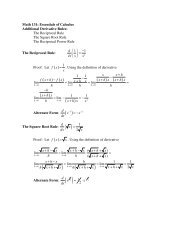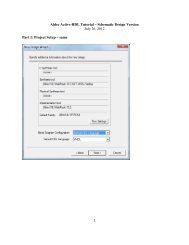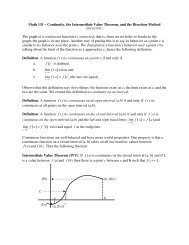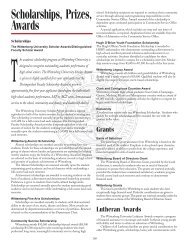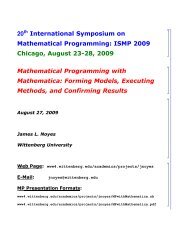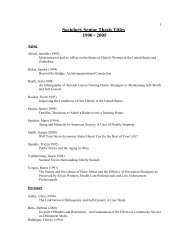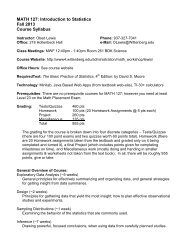1 Python to C/C++ 1. Main Program 2. Variables
1 Python to C/C++ 1. Main Program 2. Variables
1 Python to C/C++ 1. Main Program 2. Variables
Create successful ePaper yourself
Turn your PDF publications into a flip-book with our unique Google optimized e-Paper software.
<strong>Python</strong> <strong>to</strong> C/<strong>C++</strong>Fall 2011<strong>1.</strong> <strong>Main</strong> <strong>Program</strong><strong>Python</strong>: <strong>Program</strong> code is indented after colon “:”def main():body of programC/<strong>C++</strong>: Have more setup overhead.C:Both require #include directives <strong>to</strong> access libraries of subroutinesBoth require that code be enclosed within {} braces.<strong>C++</strong> (only) requires the using namespace std; directive.#include // access standard I/O routinesint main(){body of program}<strong>C++</strong>#include using namespace std;// access iostream library// namespace standard directivevoid main(){body of program}Note: Unlike in <strong>Python</strong> all statements in C/<strong>C++</strong> terminate with a semicolon “;”<strong>2.</strong> <strong>Variables</strong><strong>Python</strong>: variables are declared implicitly with the type (int, float, string) determined by the initial value assignednumber = 17x = 3.14159str = “Hello World”C/<strong>C++</strong>: All variables which are typed must be explicitly declared before any code. <strong>C++</strong> is more relaxed; variablesneed only be declared before they are used; initializations are optional.int number = 17;float x = 3.14159;char str[] = “Hello World”;string str = “Hello World”;// C only// <strong>C++</strong>1
Variable types likes int (integer), char (character), and float (or double) are simple types; arrays andstring types are structured types. In particular strings can either be implemented as type string or as arrays ofcharacters (called cstrings) which terminate with a null character (‘\0’)This is one of the big differences between <strong>Python</strong> and C/<strong>C++</strong>. <strong>Variables</strong> in <strong>Python</strong> are dynamically allocated; that isas a variable is needed, memory is allocated for the variable. This is also why a variable can change its type. On theother hand in C/<strong>C++</strong> variables are static; memory for each variable must be allocated head of time and sincedifferent data types require different amounts of memory, the type of a variable cannot change.3. Assignment StatementsFor both <strong>Python</strong> and C/<strong>C++</strong> syntax and semantics are the same except that statements in <strong>C++</strong> must terminate with asemi-colon “;”. Unlike <strong>Python</strong>, C/<strong>C++</strong> does not support simultaneous assignment statements.Note <strong>Python</strong> uses the sticky note model for assigning values <strong>to</strong> variable; <strong>C++</strong> uses the post office box model.C/<strong>C++</strong> has a richer set of algebraic opera<strong>to</strong>rs including pre and post-fix increment. For example in <strong>Python</strong> <strong>to</strong>increment a variable i, you need the assignment statementi = i+1In C/<strong>C++</strong> you can useori++; // post-fix increment++i; // pre-fix incrementwhich increments i. The two statements above produce the same results. However, you can combine pre and post fixincrements within other statements . For examplek = i++;n = ++i;// assign i <strong>to</strong> k then increment i// increment i then assign the value <strong>to</strong> n4. Input/Output<strong>Python</strong>: input and print statements; input functions like a simultaneous assignment statement with a built inprompt. If multiple values are read, they must be separated by commas.a,b = input(“Enter two integers ”)print x, yNote that print always advances <strong>to</strong> the next line; <strong>to</strong> not advance <strong>to</strong> the next line, end with a commaprint x, y,In <strong>Python</strong> formatted output is done using the “%” string formatting opera<strong>to</strong>r. The % symbols does double duty as it’salso used with the template-string as a field specifier where %d, %f, and %s specifiers denote fields for integer,floating point and string variables.print “The answer is %d\n” % (ans)2
<strong>Python</strong> also has raw_input(““) which returns any input as a string of charactersC uses the functions printf()and scanf(),putchar()and getchar()<strong>to</strong> write and read formattedoutput/input of single character output/input.printf(“%s”, “Enter two integers “);scanf(“%d %d”, &a, &b);The syntax of both printf() and scanf() require that the first parameter be a format string (this is similar <strong>to</strong>formatting output in <strong>Python</strong>). Fields for int (integer), float, char (character) or string variables are designedby %d, %c, %f, and %s. There must be agreement in number and type between the variables and/or expressions thatfollow the format string and the format fields.Optionally format fields %nd, %nc, %n.mf, and %ns where n and m are integers can be used <strong>to</strong> allocate n columnsand in the case of float variables m digits <strong>to</strong> the right of the decimal point for the corresponding variable.With scanf() the variables the follow the format string must be prefixed with ‘&’since pass by reference variablesare used (see section on parameter passing). There is an exception <strong>to</strong> the use of the ‘&”; if the parameter is an array,the & is not used (the reason has <strong>to</strong> do with the way arrays are implemented).If multiple variable re read, they only need be separated by whitespace (i.e. blanks, tabs, or newline characters(‘\n’); <strong>Python</strong> uses commas as separa<strong>to</strong>rs.For single character input, getchar() returns the next character input by the user. For examplech = getchar();For character output, putchar(ch) outputs the character ch.Note: Most of the assemble languages we’ll be studying in Comp 255 permit only single character I/O like C’sgetchar() and putchar().<strong>C++</strong> uses cin >> and cout a >> b;Note that any prompt must be done with cout
insert the value of number in<strong>to</strong> the output stream <strong>to</strong> the console output device and cin >> number; meansextract from the input stream the value for number and s<strong>to</strong>re in number. This is why we say cout a >> b; using the > (extraction) opera<strong>to</strong>rs between values/variables instead ofusing commas.Hello World Examples:<strong>Python</strong>def main():Cprint(“\nHello World\n”)#include // include I/O libraryint main(){printf(“\nHello World\n”);}<strong>C++</strong>#include using namespace std;// include I/O stream libraryvoid main(){cout
Note the bodies of the and the are enclosed between within {} braces. Also thecondition being tested, (number == 0), must be enclosed by parentheses.Multi-way branching: <strong>Python</strong> uses the elif statement (a contraction of else if); <strong>C++</strong> uses else if.6. Counting Loops<strong>Python</strong> for loopfor i in range(10):for i in [2, 3, 5, 7, 11]:In <strong>Python</strong> the loop index i iterates over the sequence taking on in turn each value in the sequence and executing thebody of the loop. The general form of the <strong>Python</strong> for loop isC/<strong>C++</strong> for loopfor in :for (int i = 0; i < 10; i++){}In <strong>C++</strong> the loop index i is initialized (i = 0), tested (i < 10) and if the test is true the body of the loop isexecuted and then the loop index is incremented (i++ or i = i + 1). This is equivalent <strong>to</strong> the first <strong>Python</strong> forloop above. Unfortunately the second <strong>Python</strong> for loop cannot be implemented in <strong>C++</strong> using a for loop. On the otherhand there are some things a <strong>C++</strong> form loop can do that a <strong>Python</strong> for can’t. The general form isfor (initial step; terminal condition; update action){}7. While LoopsLike if else statements while loops in <strong>Python</strong> and <strong>C++</strong> are similar in syntax and semantics, the main difference beingthat <strong>Python</strong> uses a colon and indents the body of the loop while <strong>C++</strong> requires parentheses around the test conditionand encloses the body of the loop within {} braces.All three languages support a break statement <strong>to</strong> exit a loop immediately<strong>Python</strong> while loopwhile a % b != 0:b = b+ 15
C/<strong>C++</strong> while loopwhile (a % b != 0){b = b+1;}Unlike <strong>Python</strong> C/<strong>C++</strong> has an explicit bot<strong>to</strong>m test loop: the do while loop. The syntax and semantics should beobvious. Note that a bot<strong>to</strong>m test loop always executes at least once.do{b = b + 1;} while (a % b != 0)Note: <strong>Python</strong> would implement the above bot<strong>to</strong>m test loop using a break statement. Note the reversed test logic usedby the <strong>Python</strong> version.while true:b = b + 1if a % b == 0:break;8. Grouping Statements – indenting vs {}<strong>Python</strong> uses indentation <strong>to</strong> group statements that are subordinate <strong>to</strong> an if, elif, or else statement that makeup the body of a loop. <strong>C++</strong> uses pairs of braces {} <strong>to</strong> do the same. In <strong>C++</strong> a set of statements enclosed by {} iscalled a compound statement.6
Euclidean Algorithm Examples<strong>Python</strong> – Note the efficient use of <strong>Python</strong>’s simultaneous assignment statements.def main():a, b = input("\nEnter two integers separated by a comma: ")while a % b != 0:a, b = b, a % bprint "\nThe gcd is %d\n" % (b)C – Since C does not support simultaneous assignment statements, a third variable r is needed <strong>to</strong> hold the remaindera % b.#include int main(){int a, b, r;printf("\nEnter two integers: ");scanf("%d %d", &a, &b); // note pass by referencewhile (a % b != 0){r = a % b;a = b;b = r;}printf("\nThe gcd is %d\n", b);}<strong>C++</strong>: I/O is the main difference between the C and <strong>C++</strong> versions of the program#include using namespace std;void main(){int a, b, r;cout > a >> b;while (a % b != 0){r = a % b;a = b;b = r;}cout
9. Strings and cstringsThere are two string data types in C/<strong>C++</strong>. The string data type in C/<strong>C++</strong> is similar in behavior <strong>to</strong> <strong>Python</strong>’s stringtype. The more primitive cstring type is an array of characters (char).For example, the declaration and initializationchar str0[] = “Hello”;creates a character array with 6 components holding the characters ‘H’, ‘e’, ‘l’, ‘l’, ‘o’ and ‘\0’, thelast being a null character (ASCII 0) . All cstrings must end with a null character.Unfortunately cstrings being array must be treated like arrays. Cstrings cannot be assigned <strong>to</strong> cstrings.So for example., given the declarationschar str0[] = “Hello”;char str1[10]; // allocate an array of capacity 10the following assignment statement will not workstr1 = str0;Instead you must assign each character in str0 <strong>to</strong> str<strong>1.</strong> This requires using a loop and knowing how manycharacters are in str0. Fortunately C/<strong>C++</strong> provides a built-in function called strlen() which returns the lengthof the stringfor (i=0; i < strlen(str0); i++){str1[i] = str0[i];}str1[i] = ‘\0’; // don’t forget terminating nullA slicker way which doesn’t use strlen() but looks for the null character ‘\0’ instead is done byfor (i=0; str0[i] != ‘\0’; i++){str1[i] = str0[i];}str1[i] = ‘\0’; // don’t forget terminating null8
String <strong>to</strong> Integer Conversion Examples<strong>Python</strong>: This program reads two strings of integers (using raw_input()) then converts both string <strong>to</strong> integervalues. To convert a string of digits <strong>to</strong> an integer, each character/digit must be converted <strong>to</strong> its correspondinginteger value. This is done by taking the ASCII code of each digit (the ord() function returns the ASCII code of acharacter) and subtracting 48. This is because the ASCII codes for the digit ‘0’ thru ‘9’ are 48 thru 57. Subtracting48 gives you the integer values 0 thru 9. Before the value of each digit is added <strong>to</strong> the number, the number ismultiplied by 10 so that each digit as it’s read has the proper weight.def main():str0 = raw_input("Enter an integer: ")k = 0for i in range(len(str0)):k = 10*k + (ord(str0[i]) - 48)str1 = raw_input("Enter another integer: ")n = 0for i in range(len(str1)):n = 10*n + (ord(str1[i])- 48)print "\nThe sum is %d\n" % (k+n)C: Here is the same code in C. Note that we do not prefix an & <strong>to</strong> str0 or str1 in the scanf() function call sinceboth are arrays. Also C does not need an explicit “ord()” function (like in <strong>Python</strong>) <strong>to</strong> return the ASCII code for acharacter. When C sees a character variable embedded in an arithmetic expression, it treats the character like aninteger using its ASCII code value.#include int main(){char str0[10], str1[10];int i, k, n;printf("\nEnter an integer: ");scanf("%s", str0);k = 0;for (i = 0; i < strlen(str0); i++){k = k * 10 + (str0[i] - 48);}printf("\nEnter another integer: ");scanf("%s", str1);n = 0;for (i = 0; i < strlen(str1); i++){n = n * 10 + (str1[i] - 48);}}printf("\nThe sum is %d\n", k+n);9
10. Functions and ProceduresIn <strong>Python</strong> and C/<strong>C++</strong> functions are defined and called in much that same way.In <strong>Python</strong> the following code defines a function which computes n fac<strong>to</strong>rial.def fac<strong>to</strong>rial(n):p = 1for k in range(1,n+1):p = p * kreturn pFunctions are define before the main() programIn C/<strong>C++</strong> the same function can be implemented by the code below. The main difference is that all parameters aremust be explicitly typed in the function definition.int fac<strong>to</strong>rial(int n){int p = 1;int k;for (k = 1; k
C: Again the same as the above with the code <strong>to</strong> convert a string of digits in<strong>to</strong> an integer consolidated in<strong>to</strong> afunction#include int str2int(char s[]){int i;int n = 0;for (i = 0; i < strlen(s); i++){n = n * 10 + (s[i] - 48);}return n;}int main(){char str0[10], str1[10];int i, k, n;char ch;printf("\nEnter an integer: ");scanf("%s", str0);k = str2int(str0);printf("\nEnter another integer: ");scanf("%s", str1);n = str2int(str1);}printf("\nThe sum is %d\n", k+n);1<strong>1.</strong> ParametersIn <strong>Python</strong> and C/<strong>C++</strong> all parameters are pass by value; that is the value of the actual parameter (the parameter usedwhen the function is called or invoked) is assigned <strong>to</strong> the formal parameter (the parameter used in the functiondefinition). Thereafter the connection between the actual parameter and the formal parameter is broken so anychange made <strong>to</strong> the formal parameter does not change the actual parameter. It’s a one way transfer of information.In C/<strong>C++</strong> the number and type of the actual parameters must agree with the number and type of the formalparameters; order is important. The same is more or less true in <strong>Python</strong> but not strongly enforced.Functions return values, hence the return statement. In C/<strong>C++</strong> the return type must be explicitly defined in theheader of the function (in the fac<strong>to</strong>rial example above, the initial int in the function header declares the return type).In <strong>Python</strong> it is possible for a function <strong>to</strong> return more than one value; This is not possible in C/<strong>C++</strong>; functions inC/<strong>C++</strong> may only return one value.There are programming situations where we would like a function <strong>to</strong> either modify its parameters or return multiplevalues. Since <strong>Python</strong> allows a function <strong>to</strong> return multiple values, there are easy “work-arounds” for both of these butnot so with C/<strong>C++</strong>. For example, suppose we want <strong>to</strong> write a function that exchanges two values; that is, if youpassed it two variables a and b it would exchange the values so that a would be equal <strong>to</strong> the old value of b and bwould be equal <strong>to</strong> the old value of a. The pass by value parameter passing convention does not allow changes <strong>to</strong>parameters. So how can this be done?11
We’ll examine first how this is done in <strong>C++</strong> (C uses a more explicit mechanism). <strong>C++</strong> allows a second type ofparameter passing called pass by reference. In pass by reference the actual parameters and the formal parametersare linked during the functions call so any change <strong>to</strong> one results in a change of the other. <strong>C++</strong> denotes pass byreference parameters using an “&” in the definition of the function (see below). So when exchange(a, b) iscalled in the main() function, the actual parameter a is linked <strong>to</strong> the formal parameter a (even thought they are thesame name, their full names are a.main and a.exchange) and the actual parameter b (or b.main) is linked <strong>to</strong>the formal parameter b (or b.exchange). Thereafter any change <strong>to</strong> one results in a change <strong>to</strong> the other.#include using namespace std;void exchange(int &a, int &b) // pass by reference parameters{int c;c = a;a = b;b = c;}void main(){int a, b;cout > a >> b;exchange(a, b);cout
Ok how does this allow actual and formal parameters <strong>to</strong> be linked so that a change in one causes a change in theother?When we call exchange(&a, &b) (see below) the ampersand in the parameter calls next <strong>to</strong> the actual parametersays pass the address (not the value) of actual parameters a and b.In the definition of exchange the formal parameters a.exchange and b.exchange are pointer type variables;they now hold the addresses of a.main and b.main.The assignment statement c = *a assigns the what a.exchange points <strong>to</strong> (*a means “the value that a points <strong>to</strong>”),in this case a.main, <strong>to</strong> c. The next assignment statement *a = *b says assign what b points <strong>to</strong> (in this case thevalue of b.main) <strong>to</strong> what a points <strong>to</strong> (in this case a.main). So a.main is assigned the value b.main! Finally*b = c says assign c (which is a.main) <strong>to</strong> what b points <strong>to</strong> (b.main)The mechanism is still pass by value (the addresses in a.exchange and b.exchange never change) but theeffect is pass by reference in that the values of a.main and b.main and what a.exchange and b.exchangepoint <strong>to</strong> change.#include void exchange(int *a, int *b) // pointer type parameters{int c;c = *a; // assign <strong>to</strong> c what a points <strong>to</strong>*a = *b;*b = c;}int main(){int a, b;// define two integer variablesprintf("\nEnter two integers: ");scanf("%d%d", &a, &b);exchange(&a, &b); // pass their addresses <strong>to</strong> exchangeprintf("\nReversed: %d %d\n", a, b);}Syntactically just remember <strong>to</strong> declare all “pass by reference” formal parameters using *’s, <strong>to</strong> use *’s whenreferring <strong>to</strong> the formal parameters in the function and <strong>to</strong> use ampersands when passing the actual parameters – and itall works out nicely.Note final note. In C/<strong>C++</strong> array parameters use a pass by reference mechanism but without the syntactical “*” and“&” baggage (recall the int str2int(char s[]) function above). That’s because in C/<strong>C++</strong> arrays areactually implemented using a pointer type mechanism; de-referencing is au<strong>to</strong>matic so no explicit de-referencing onthe part of the programmer is need.Rev 08/24/201113




